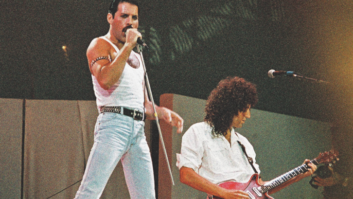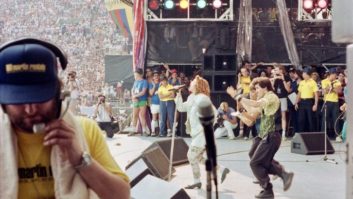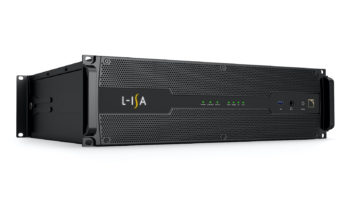On Aug. 3, Drew Thornton, a 2007 CRAS Graduate and Current Front of House Engineer, Invited Multiple CRAS Students to the Teddy Swims Concert at Arizona Financial Theatre in Phoenix

Gilbert, Ariz., Sept. 2, 2025 – Students from the Conservatory of Recording Arts & Sciences (CRAS; www.cras.edu), a leading institution for audio engineering education, recently had the opportunity to meet 2007 CRAS graduate Drew Thornton, FOH engineer for Teddy Swims during his “I’ve Tried Everything But Therapy Tour”. On Aug. 3, multiple students were able to accompany Thornton as he performed the concert mix at the Arizona Financial Theatre in Phoenix. The following day, Thornton visited the CRAS campus where he participated in a panel discussion involving his experiences on the road.
“I was definitely excited to give back,” said Thornton. “In my career up to this point, I’ve been very lucky, but I also know that it wasn’t just luck. It was also hard work and exercising the principles taught in at CRAS that helped me succeed. The ability to give back is very important to me.”
Thornton is responsible for the concert’s live mix as well as providing mixes for some of Teddy Swims’ social media posts, as well as archiving multitrack recordings and dealing with broadcast feeds for festivals.
“I feel like I wasn’t really interested in live sound when I was going to school, and so I wanted to share some of the exciting new changes since I graduated,” Thornton continued. “Live sound has changed dramatically since 2007. It’s a very fast moving department of audio and there has been exciting transformations of what we are capable of doing live, and I wanted to have the ability to share that with the up-and-coming students.”
Thornton explained that during the show’s audio prep, he realized he had to do several changes on the fly in front of the students, which further validated his point of always being ready to make changes in the moment.
“I learned so much from Drew,” said CRAS student Mike Awalt. “He talked about information that we have learned in school, but he applied it to what he was doing to put on a show which really spoke to me because it showed how even the most minor details are very crucial to fine tuning the band, and creating the atmosphere for the audience before the show even starts. It was incredible seeing him work, but also hearing where his path took him to get him there.”

Thornton added that the live world continues to advance very rapidly based on new micro chips and faster processing power. There have also been a lot of changes with mentality towards analog and digital and how they coexist. “Even with what you can do just within the digital realm has been very exciting. That isn’t even touching the surface of the technology of current PAs these days. The amount of detail, prediction software, and technology behind some of these PAs are very impressive. It’s an exciting time to be an engineer. We have the ability to bring forth a lot more detail than we ever have, and it’s not just expensive gear either. There are a lot of affordable options that can do a lot, making its accessibility greater than ever.”
Said CRAS student Lyssa Lynn, “Watching a pro FOH mixer made me realize mixing isn’t just about sound, it’s about reading the room and controlling the energy. Being behind the console showed me how much trust is placed in the FOH engineer to make the artist sound their absolute best. I got to see how a great FOH engineer thinks ahead, always anticipating what’s coming next on stage.”
Added CRAS student Joe Stelzner, “It was a great pleasure to meet Drew. Hearing about his real-world experiences as a professional audio engineer was both eye-opening and insightful. His passion for his work was truly inspiring.”
Besides his own experience, Thornton said that he has been impressed of what kind of reputation CRAS has out in the field.
“When I talk to other engineers, they always have good things to say about CRAS grads,” Thornton explained. “Personally, I feel like those were some of my favorite times. I think it was the first time I found something that spoke deeply to me, and having the resources to be able to fully immerse myself in the studio and getting my hands on the gear.”
Thornton concluded by saying that student should take advantage of everything they can. “Do all the extra classes, do all the practice time you can, ask all the questions you can, and take advantage of all the things CRAS has to offer. Take advantage of the safe space that you have so that way when you go out to the field, you are as prepared as you can be.”
The Conservatory of Recording Arts & Sciences is composed of two nearby campuses in Gilbert and Tempe, Ariz. A CRAS education includes broadcast audio, live sound, film and TV audio, music, and video game audio, all taught by award-winning instructors who have all excelled in their individual fields, including sound reinforcement, audio recording and production, digital recording, troubleshooting/maintenance, and music business.
CRAS structured programs and highly qualified teaching staff provide a professional and supportive atmosphere, which is complemented by its small class sizes allowing for individual instruction and assistance for students in engineering audio recordings. CRAS has been providing quality vocational training in audio recording for more than three decades. The curriculum and equipment are constantly being updated to keep pace with the rapid advancements in the music and sound recording industries. CRAS’ course offerings and subject matter have always centered around the skills and knowledge necessary for students’ success in the audio recording industries.
The 11-month program is designed to allow every student access to learn and train in all of the Conservatory’s studios which are comprised with state-of-the-art audio recording and mixing gear, the same equipment used in today’s finest studios and remote broadcast facilities, including Pro Tools 12, API Legacy consoles, SSL AWS consoles, Studer Vista consoles, and much more. All students must complete a 280-hour industry internship to graduate from the Master Recording Program II that may ultimately lead to industry employment.
For more information on the Conservatory of Recording Arts & Sciences, please visit www.cras.edu, contact Kirt Hamm, administrator, at 1-800-562-6383, or email to [email protected].
About The Conservatory of Recording Arts & Sciences
Based in the heart of The Valley of the Sun with two campuses in Gilbert and Tempe, Ariz., The Conservatory of Recording Arts & Sciences (CRAS) is one of the country’s premier institutions for audio education. The Conservatory has developed a unique and highly effective way to help the future audio professional launch their careers in the recording industry and other related professional audio categories.
-30-







